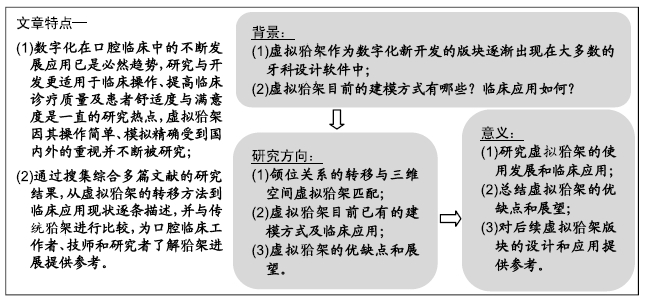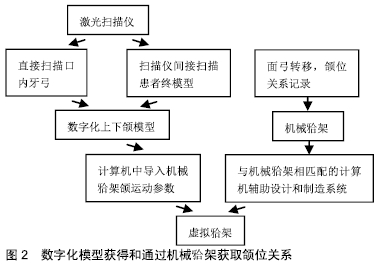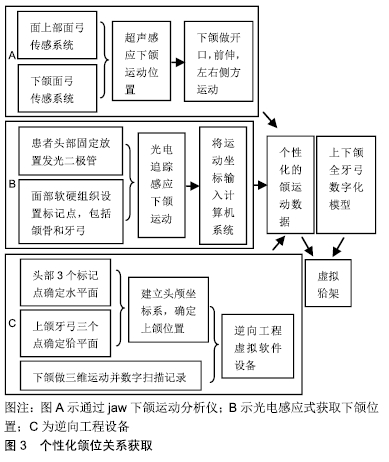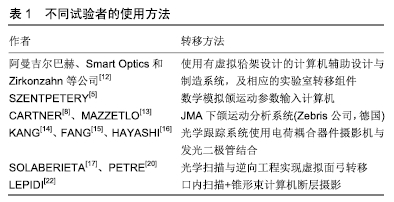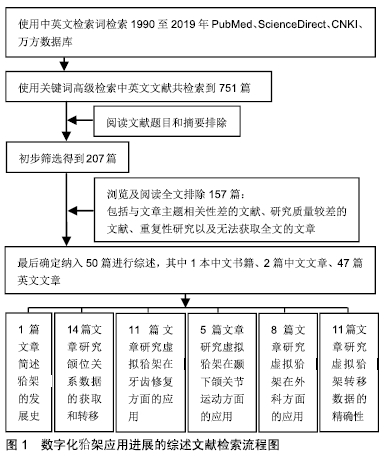[1] QUINLAN P. Articulators, face bows and interocclusal records. J Ir Dent Assoc. 2016;62(2):102-104.
[2] OANCEA L, STEGAROIU R, CRISTACHE CM. The influence of temporomandibular joint movement parameters on dental morphology. Ann Anat. 2018;218(7):49-58.
[3] WANG M, MEHTA N.A possible biomechanical role of occlusal cusp-fossa contact relationships.J Oral Rehabil. 2013;40(1):69-79.
[4] HSU MR, DRISCOLL CF, ROMBERG E, et al. Accuracy of dynamic virtual articulation: trueness and precision. J Prosthodont.2019;28(4): 436-443.
[5] KORALAKUNTE PR, ALJANAKH M.The role of virtual articulator in prosthetic and restorative dentistry.J Clin Diagn Res. 2014;8(7): ZE25-28.
[6] 刘峰,师晓蕊.面弓架应用基本技术[M].北京:人民卫生出版社, 2018.
[7] GHANAI S, MARMULLA R, WIECHNIK J, et al. Computer-assisted three-dimensional surgical planning: 3D virtual articulator: technical note. Int J Oral Maxillofac Surg. 2010;39(1):75-82.
[8] MAESTRE-FERRÍN L, ROMERO-MILLÁN J, PEÑARROCHA-OLTRA D, et al. Virtual articulator for the analysis of dental occlusion: an update. Med Oral Patol Oral Cir Bucal. 2012;17(1):e160-163.
[9] ÚRY E, FORNAI C, WEBER GW. Accuracy of transferring analog dental casts to a virtual articulator. J Prosthet Dent. 2019. pii: S0022-3913(19)30073-3.
[10] ENCISO R, MEMON A, MAH J. Three-dimensional visualization of the craniofacial patient: volume segmentation, data integration and animation. Orthod Craniofac Res. 2003;6 Suppl 1:66-71; discussion 179-182.
[11] STAVNESS IK, HANNAM AG, TOBIAS DL, et al.Simulation of dental collisions and occlusal dynamics in the virtual environment. J Oral Rehabil. 2016;43(4):269-278.
[12] ALGHAZZAWI TF.Advancements in CAD/CAM technology: Options for practical implementation. J Prosthodont Res. 2016;60(2):72-84.
[13] MAZZETTO MO, ANACLETO MA, RODRIGUES CA, et al. Comparison of mandibular movements in TMD by means of a 3D ultrasonic system and digital caliper rule. Cranio. 2017; 35(1):46-51.
[14] KANG DW, MONGINI F, ROSSI F, et al. A system for the study of jaw movements. Cranio. 1993;11(1):63-67.
[15] FANG JJ, KUO TH. Modelling of mandibular movement. Comput Biol Med. 2008;38:1152-1162.
[16] HAYASHI T, KUROKAWA M, MIYAKAWA M, et al. A high-resolution line sensor-based photostereometric system for measuring jaw movements in 6 degrees of freedom. Front Med Biol Eng.1994;6(3): 171-186.
[17] SOLABERRIETA E, OTEGI JR, MÍNGUEZ R, et al.Improved digital transfer of the maxillary cast to a virtual articulator. J Prosthet Dent. 2014;112(4):921-924.
[18] SOLABERRIETA E, GARMENDIA A, MINGUEZ R, et al. Virtual facebow technique. J Prosthet Dent. 2015;114(6):751-755.
[19] SOLABERRIETA E, ARIAS A, BRIZUELA A, et al. Determining the requirements, section quantity, and dimension of the virtual occlusal record. J Prosthet Dent. 2016;115(1):52-56.
[20] PETRE A, DRAFTA S, STEFANESCU C, et al. Virtual facebow technique using standardized background images. J Prosthet Dent. 2019;121(5):724-728.
[21] MANGANO C, LUONGO F, MIGLIARIO M, et al. Combining intraoral scans, cone beam computed tomography and face scans: the virtual patient. J Craniofac Surg. 2018;29(8): 2241-2246.
[22] LEPIDI L, CHEN Z, RAVIDA A, et al. A full-digital technique to mount a maxillary arch scan on a virtual articulator. J Prosthodont. 2019;28(3): 335-338.
[23] KORDASS B, GÄRTNER C, SÖHNEL A, et al. The virtual articulator in dentistry: concept and development. Dent Clin North Am. 2002;46: 493-506.
[24] MCCORMICK SU, DREW SJ. Virtual model surgery for efficient planning and surgical performance. J Oral Maxillofac Surg. 2011;69(3): 638-644.
[25] QUAST A, SANTANDER P, WITT D, et al.Traditional face-bow transfer versus three-dimensional virtual reconstruction in orthognathic surgery. Int J Oral Maxillofac Surg. 2019;48(3):347-354.
[26] RITTO FG, SCHMITT ARM, PIMENTEL T, et al.Comparison of the accuracy of maxillary position between conventional model surgery and virtual surgical planning. Int J Oral Maxillofac Surg. 2018;47(2): 160-166.
[27] ZARAGOZA-SIQUEIROS J, MEDELLIN-CASTILLO HI, DE LA GARZA-CAMARGO H, et al.An integrated haptic-enabled virtual reality system for orthognathic surgery planning.Comput Methods Biomech Biomed Engin. 2019;22(5):499-517.
[28] CHIN SJ, WILDE F, NEUHAUS M, et al.Accuracy of virtual surgical planning of orthognathic surgery with aid of CAD/CAM fabricated surgical splint-A novel 3D analyzing algorithm.J Craniomaxillofac Surg. 2017;45(12):1962-1970.
[29] HANAFY M, AKOUSH Y, ABOU-ELFETOUH A, et al. Precision of orthognathic digital plan transfer using patient-specific cutting guides and osteosynthesis versus mixed analogue-digitally planned surgery: a randomized controlled clinical trial. Int J Oral Maxillofac Surg. 2019. pii: S0901-5027(19)31217-2.
[30] RIOS HF, BORGNAKKE WS, BENAVIDES E. The use of cone-beam computed tomography in management of patients requiring dental implants: an american academy of periodontology best evidence review. J Periodontol. 2017; 88(10):946-959.
[31] ZIZELMANN C, HAMMER B, GELLRICH NC, et al. An evaluation of face-bow transfer for the planning of orthognathic surgery. J Oral Maxillofac Surg. 2012;70:1944-1950.
[32] LAM WYH, HSUNG RTC, CHOI WWS, et al.A clinical technique for virtual articulator mounting with natural head position by using calibrated stereophotogrammetry. J Prosthet Dent. 2018;119(6): 902-908.
[33] HUGGER A, BÖLÖNI E, BERNTIEN U, et al. Accuracy of an ultrasonic measurement system for jaw movement recording. J Dent Res. 2001; 80:1226.
[34] UCHIDA T, SAKAI J, OKAMOTO Y, et al. Studies evaluating measurement accuracy of CMS-JAW, a jaw motion tracking device with six degrees of freedom using an ultrasonic recording system.Nihon Hotetsu Shika Gakkai Zasshi. 2008;52(3):350-359.
[35] FERRATO G, FALISI G, IERARDO G, et al. Digital evaluation of occlusal forces: comparison between healthy subjects and TMD patients. Annali di Stomatologia. 2017;VIII(2):79-88.
[36] KIJAK E, LIETZ-KIJAK D, FRĄCZAK B, et al. Assessment of the TMJ dysfunction using the computerized facebow analysis of selected parameters. Biomed Res Int. 2015; 508069-1-508069-9.
[37] AHLERS MO, BERNHARDT O, JAKSTAT HA, et al. Motion analysis of the mandible: guidelines for standardized analysis of computer-assisted recording of condylar movements.Int J Comput Dent. 2015;18(3):201-223.
[38] RATZMANN A, MUNDT T, SCHWAHN C, et al. Comparative clinical investigation of horizontal condylar inclination using the JMA electronic recording system and a protrusive wax record for setting articulators. Int J Comput Dent. 2007;10(3): 265-284.
[39] 黄超,许向亮,孙玉春,等.下颌髁突功能面三维运动轨迹的初步推算和模拟[J].中华口腔医学杂志,2018,53(10):669-673.
[40] 王晶,陈俊鹏,王洋,等.数字化下颌运动记录及咀嚼肌肌电图在下颌骨肿瘤患者口颌功能评价中的应用[J].北京大学学报(医学版), 2019,51(3): 571-578.
[41] KWON JH, IM S, CHANG M, et al. A digital approach to dynamic jaw tracking using a target tracking system and a structured-light three-dimensional scanner. J Prosthodont Res. 2019;63(1):115-119.
[42] KIM JE, PARK JH, MOON HS, et al.Complete assessment of occlusal dynamics and establishment of a digital workflow by using target tracking with a three-dimensional facial scanner.J Prosthodont Res. 2019;63(1):120-124.
[43] KALMAN L, CHRAPKA J, JOSEPH Y. Digitizing the Facebow: A Clinician/Technician Communication Tool.Int J Prosthodont. 2016; 29(1):35-37.
[44] HSU MR, DRISCOLL CF, ROMBERG E, et al. Accuracy of Dynamic Virtual Articulation: Trueness and Precision.J Prosthodont. 2019;28(4):436-443.
[45] DELONG R, KNORR S, ANDERSON GC, et al.Accuracy of contacts calculated from 3D images of occlusal surfaces.J Dent. 2007;35(6): 528-534.
[46] LEE H, CHA J, CHUN YS, et al.Kim M.Comparison of the occlusal contact area of virtual models and actual models: a comparative in vitro study on Class I and Class II malocclusion models. BMC Oral Health. 2018; 18(1):109.
[47] SOLABERRIETA E, OTEGI JR, GOICOECHEA N, et al. Comparison of a conventional and virtual occlusal record. J Prosthet Dent. 2015; 114(1):92-97.
[48] SHETTY S. Virtual articulators and virtual facebow transfers: Digital prosthodontics.J Indian Prosthodont Soc. 2015;15(4): 291.
[49] BHAMBHANI R, BHATTACHARYA J, SEN SK.Digitization and its futuristic approach in prosthodontics.J Indian Prosthodont Soc. 2013; 13(3):165-174.
[50] HASSAN B, GIMENEZ GONZALEZ B, TAHMASEB A, et al. A digital approach integrating facial scanning in a CAD-CAM workflow for complete-mouth implant-supported rehabilitation of patients with edentulism: A pilot clinical study. J Prosthet Dent. 2017;117:486-492.
|
